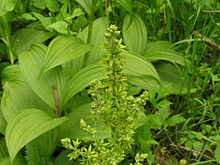Veratrum viride

Veratrum viride, known as Indian poke, corn-lily, Indian hellebore, false hellebore, green false hellebore,[2] or giant false-helleborine,[3] is a species of Veratrum native to eastern and western (but not central) North America.[4][2][5] It is extremely toxic, and is considered a pest plant by farmers with livestock. The species has acquired a large number of other common names within its native range, including American false hellebore, American white hellebore, bear corn, big hellebore, corn lily, devils bite, duck retten, itch-weed, itchweed, poor Annie, blue hellebore and tickleweed.
V. viride is a herbaceous perennial plant reaching 0.7 to 2 metres (2.3 to 6.6 ft) tall, with a solid green stem. The leaves are spirally arranged, 10 to 35 cm (4 to 14 in) long and 5 to 20 cm (2 to 8 in) broad, elliptic to broad lanceolate ending in a short point, heavily ribbed and hairy on the underside. The flowers are numerous, produced in a large branched inflorescence 30 to 70 cm (1.0 to 2.3 ft) tall; each flower is 5 to 12 mm (0.2 to 0.5 in) long, with six green to yellow-green tepals. The fruit is a capsule 1.5 to 3 cm (0.6 to 1.2 in) long, which splits into three sections at maturity to release the numerous flat 8 to 10 mm (0.3 to 0.4 in) diameter seeds. The plant reproduces through rhizome growth as well as seeds.[4][6][7][8]
The plant is highly toxic, causing nausea and vomiting. If the poison is not evacuated, cold sweat and vertigo appear. Respiration slows, while cardiac rhythm and blood pressure fall.[11] The toxic effects of veratrum alkaloids[11] are directly induced by antagonism of adrenergic receptors.
It is used externally by several Native American nations. Although is rarely ever used in modern herbalism due to its concentration of various alkaloids, it has been used in the past against high blood pressure and rapid heartbeat; a standardized extract of V. viride alkaloids known as alkavervir was used in the 1950s and 1960s as an antihypertensive.[12][13] The root contains even higher concentrations than the aerial parts.[14]
The plant was used by some tribes to elect a new leader. All the candidates would eat the root, and the last to start vomiting would become the new leader.[15]
